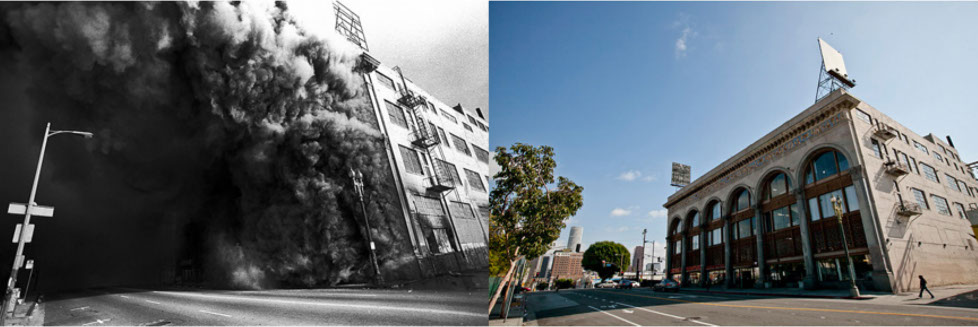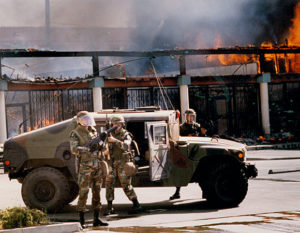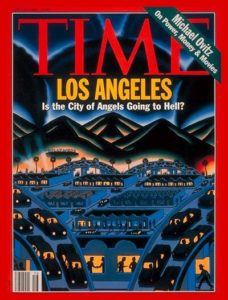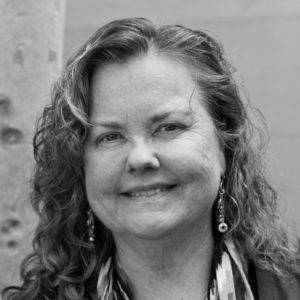Can We All Get Along?
Posted 04/25/2017 in Responses To World Events
LOS ANGELES CIVIL UNREST, 25 YEARS LATER

Young’s Market Company building at Seventh Street and Union Avenue in the Westlake district.
I can still smell the smoke and feel the despair I felt as I stood with my immigrant neighbors and watched our neighborhood be looted and burned. A pick-up truck with young men had come down our street and thrown Molotov cocktails into the historic building (pictured above) that served as a swap meet/marketplace on the corner. We all stood on the corner and watched as it burned. A fire truck came through, watched the fire burn for a few minutes, and then left. We were alone, wondering what was happening to our neighborhood and city.
Our ministry team had lived in this neglected corner of Los Angeles for several years. Along with our neighbors, we held our collective breath while the jury in neighboring Simi Valley acquitted the police officers in the Rodney King beating case. We knew there would be trouble, but we did not expect the explosion that would take over our city for the next three days. On April 29, we could see the smoke in South LA from the balcony of our crowded apartment building. I watched with my young Mexican American friend G, who remarked that if there is no justice for Blacks, then there will never be justice for Latinos either. Little did we know that the fires in South LA would burn all night and make their way to our neighborhood, a Latino immigrant area sandwiched between downtown and Koreatown.

The National Guard was called to our city, we were put on curfew. A few days later, when businesses and stores were beginning to reopen, the police came through our building to reclaim any items that looked new. If residents could produce a receipt, then they could keep the item. If not, it was assumed to be looted from the nearby swap meet or furniture store. My friend Hortenica, eight month pregnant, had her mattress taken. Miguel had his Christmas bicycle taken. We worked for months to get it back but without success. Statistics were released: 53 people were killed, and over 1,000 businesses were burned to the ground. No statistics could measure the impact on our souls and on the charred soul of our city.
A week after our social earthquake, pastors and other church leaders gathered for our quarterly Love LA prayer gathering. It was standing room only as we gathered to pray and tried to gain a bit of perspective on what had happened in our city. Rodney King famously asked, a few days after the fires started, “Can we all get along?” In the early ’90s, a report from the mayor’s office had described LA as a mosaic, with distinct colors, each section vibrant and essential to the whole. The civil unrest of 1992 called into question this glowing image of our city. The many churches in our city had to face the question of how this happened in a city with so many churches.

In 1993, Time magazine featured LA on its cover with the heading, “Is the City of Angels going to hell?” After the civil unrest, there were serious fires in 1993, and an earthquake in January 1994. Many people left for other cities, or more suburban locations, but the rebuilding did happen. Much of this was not through the official Rebuild LA effort, but through market forces. Immigrants, especially the Koreans, brought much energy and many resources to Los Angeles. Some years later, when asked how they felt about life in LA, most people either had not even lived here then, or said they were hopeful about the future of LA. Significantly, but not surprisingly, the one group that was less hopeful was African Americans. Missiologically, we need to ask why this is the case. If a society is flourishing, then all its people must also be flourishing.
In 1992, we could not have imagined LA 25 years later, in 2017. Downtown LA (DTLA) has seen the revitalization that has hit other main urban centers in the United States, with all the pros and cons that gentrification brings (that is another blog post). A generation of young people raised in the suburbs is moving to the cities, while poverty is increasingly moving to the suburbs. In 1992, we could not have imagined a church like New City Church in the historic core, with a vision to bring together the various people of DTLA, Skid Row residents, loft dwellers and the rest of us. The demographic currently is one quarter of each of the major ethnic groups. With a vision to care for its neighborhood as a parish, New City is not a church where the resourced care for the poor, but where we are all together equally in need of God’s grace. As much as services are needed in our cities, they do not remove the dividing walls between us. Being together in worship is where we experience our kinship, where the other becomes part of us. There are no platforms at the cross of Jesus.
The civil unrest is more than a historical event for reflection, it also reflects our current social reality. A recent survey by Loyola Marymount University found that for the first time in two decades, a majority of Angelenos believe another riot/uprising is possible. Rodney King’s question, Can We All Get Along, is as relevant now as it was 25 years ago.
Five missiological reflections from the events of 1992:
1. Lament: The move from the fires to rebuilding was rapid. Those from other areas were quick to come clean up our neighborhoods, but for those who lived here, the ashes were not so easily cleaned up. They represented years of disenfranchisement and injustices. Today as I write, it is Holy Saturday, Jesus has been crucified but the Resurrection is still to come. It is an uncomfortable time. It is easy to begin to celebrate, knowing the resurrection is imminent. But there is work that happens on Holy Saturday, the in-between time.
2. Police and city systems: The police department under then-chief Gates was notorious for the ways they did not engage positively with urban neighborhoods. One of the major changes after 1992 was the reform of the police department, which moved from a largely white department to one that reflects Los Angeles. It is not perfect now but so much better than in 1992. This raises the question—as God’s people, what is our engagement with the systems of a city? Do we focus on personal conversion and transformation, or are we also looking for transformation in the systems of our city, systems that reflect fairness for all peoples? What does it mean to seek the Shalom of the entire city to which we have been called, as Jeremiah 29 calls us to?
3. Many narratives: An event like the civil unrest of 1992 cannot be explained in one narrative, although there have been many such attempts. Depending on one’s social location and culture, the narrative of the unrest varied greatly. The different words used to describe the civil unrest reflect this. Was it a riot? An uprising? A rebellion? A wake up call? A social earthquake? We need to listen to the many narratives in our city. The Korean community had its own narrative, a painful one, that was sometimes misunderstood. Latinos have their own story of not feeling as if they belong in a city that once belonged to Mexico. African Americans look back on a long history of injustice within our cities, including the Watts Riots of 1965. We need to take the time to hear the various narratives and not make assumptions about the causes of events based on where we stand or our own cultural perspective.
4. Mosaic as metaphor: A colorful mosaic may at first seem a useful metaphor for a city like LA, reflecting different cultures sharing the whole. However, it does not answer the question of how we will all get along. How do we cross the barriers that separate the colors of the mosaic? The dividing wall that Jesus came to break still stand in a mosaic. Jesus finished the work of breaking these dividing walls, but as God’s people, we need to walk through those broken walls in relationship with each other, across the divides. Mission includes not only ministry within each section of the mosaic, but movement between the parts. Within sociology, cultural hybridity is increasingly used as a way to describe our current world. An example in Los Angeles is the very popular Kogi taco truck, a Korean chef making tacos using blending elements of Korean and Mexican cuisine.
5. So many churches, so little transformation: The civil unrest served as a clarion call to the church to step outside her walls and be a church of the city and with the city, not only located within the city. What does it mean to be not only many churches in the city, but the Church in the city? An example comes from Los Angeles. Initiated by New City Church, the downtown clergy council hosts quarterly trust talks, started as a response to a police killing of a man known as Africa on Skid Row. These trust talks bring together the various stakeholders in DTLA to talk to each other around the table.
The face of mission and missiology has also changed much over these 25 years. In 1992, the School of World Mission (now School of Intercultural Studies) was known for church growth and the homogenous unit principle. Mission was largely still seen as crossing from one culture to another, often a “Western” to “non-Western.” Twenty-five years later, mission is a global movement, a witness of many peoples to many peoples. In an increasingly urbanized world, mission is not only crossing barriers to another people group, but intercultural, asking how we can all get along. Interreligious dialogue and peacebuilding are now part of our curriculum. In November 2017, SIS will host the Missiology Lectures on Race and Mission. This anniversary of the social earthquake that shook LA is a good time to continue to ask, “Can we all get along?”

Jude Tiersma-Watson is associate professor of urban mission in Fuller’s School of Intercultural Studies. She has lived in the Westlake Pico Union neighborhood of LA for over 25 years as a member of InnerChange/CRM, a Christian Order Among the Poor.

